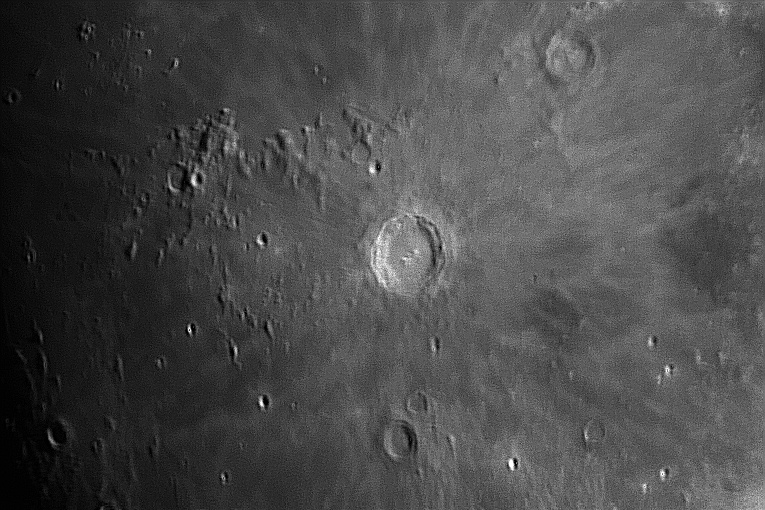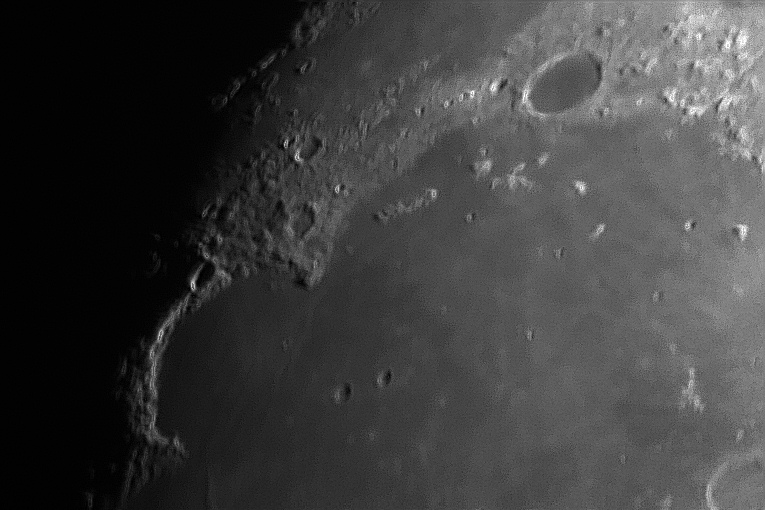

Vol. 28 No. 7 April 1999 http://physics.weber.edu/oas/oas.html
THE APRIL MEETING
The April meeting of the Ogden Astronomical Society will be held this Thursday April 8, 1999 in the Ott Planetarium on the Weber State University campus. The meeting will be called to order at 7:30 p.m.
A video titled "Powers of Ten" will be shown. Following the video, Wayne Sumner will discuss the various methods astronomers use when determining distances in space.
ANOTHER SEASON OF ANTELOPE ISLAND EVENTS BEGINS IN APRIL
The last time OAS members gathered to host a public star party at the island was last October. That was six months ago - can you believe it?
The 1999 series of Antelope events bravely begins on Saturday April 17, 1999. Bravely because April weather has been a disappointing factor in years past so with a little luck and maybe a knee bend to the weather gods maybe we can pull off an early public event.
The rules and meeting place are the same as it has always been; meet at the White Rock Bay (dirt) parking lot before dusk and let's leave the site as we find it, pristine. If there are questions, you may raise them at the April meeting or contact a member of your executive committee.
THE PRESIDENT'S PARSEC
Greetings Earthlings. Well we got what we wanted for the Antelope Island Messier Marathon, sort of. Weather wise it was a perfect day. Blue skies and temps at 70 degrees and Friday night it stayed at about 45 with occasional warm breezes from the lake.
In attendance for the event were V.P. Dave Dunn, Brent Barker, young aspiring astronomer Chris Miller, and the Prez and first lady w/ dogs.
As the sun dropped into the lake that evening high thin clouds from the west started to invade an otherwise perfect sky. The darker it got the more they canvassed the sky, blocking the view of some of the objects we needed to see first before they went over the horizon. Not a good start. Also the moisture and dust in the atmosphere scattered the city lights far up into the sky. When the optics began to collect dew around midnight discouragement trumped our enthusiasm and we called it a night. ( what else would you call it, the sun was down ?) We did manage to log about 40 M objects up to that point and had a great time in the process despite the sky conditions. It's like the bumper sticker says " my worst nite observing the stars is better than my best day golfing" or is it "time spent logging Arp galaxies cannot be subtracted from a mans life" but it might be " I brake for star parties " how about " start seeing faint planetaries" (say uncle or I'll keep going) whatever.
the Prez.
MINUTES
OGDEN ASTRONOMICAL SOCIETY
March 11, 1999
President Ron Vanderhule called the regular meeting of the Ogden Astronomical Society to order at 7:30 p.m. in the Ott Planetarium.
Business included: We need a dark sky location to hold a Messier Marathon. One suggestion that is being considered is in Morgan by the school football stadium. The other is Stansbury Park. We will continue working on our Telescope mirrors on Saturday 3/13 at 10:00 a.m. RTMC application forms were made available to those that want them.
Dr. Sohl gave an update on the observatory. He is trying to find a good place for it. The place he likes best is on the hill by the stadium. It will cost about $30,000 dollars more than he has to build it on that site. If anyone wants an observatory named after them he could use a $30,000 donation.
The main part of the meeting was Show and Tell. Ron Vanderhule had some models that demonstrated comparative size and distance of galaxies that are near the Milky Way.
Dale Hooper presented a 20 minute video taken at infrared of a portion of the Milky Way.
Dave Miller had a German astrocamera with all the attachments to take pictures through a scope. He also had a large lense and some plans for turning it into a telescope. He wants to sell these items.
The meeting then adjourned to informal discussion at 9:00 p.m.
David Dunn V.P.
The following was pulled off the web by Dr. Sohl:
MEDIA RELATIONS OFFICE
JET PROPULSION LABORATORY
CALIFORNIA INSTITUTE OF TECHNOLOGY
NATIONAL AERONAUTICS AND SPACE ADMINISTRATION
PASADENA, CALIFORNIA 91109.
FOR IMMEDIATE RELEASE March 25, 1999
EXPERIMENT LAYS GROUNDWORK FOR 'LIVING OFF THE LAND' ON MARS
NASA engineers have succeeded in a realm often left to alchemists and magicians -- creating something valuable "out of thin air." In this case, the thin air was a simulated Martian atmosphere, and the valuable commodity was oxygen.
"The concept is to use the resources on Mars to reduce the amount of material that needs to accompany a human mission... to 'live off the land,' " said David Kaplan, principal investigator of the Exploration Office at NASA's Johnson Space Center, Houston, Texas. "Producing oxygen using materials readily available on Mars would be an important step toward reducing the costs and risks of an eventual human mission to Mars." This week's demonstration is an initial test of technology that will be aboard the Mars Surveyor 2001 Lander, scheduled to launch April 10, 2001, and land on Mars on January 22, 2002. Called the Mars In-Situ Propellant Production Precursor, the experiment will test the feasibility of using the thin Martian atmosphere to produce oxygen for breathing air and propellants. Propellants created on Mars could eventually be used to send samples and astronauts back to Earth.
"The oxygen production technology being tested this week is based on sound, straightforward chemistry," said Jerry Sanders of Johnson's Propulsion and Fluid Systems Branch. The primary test involves an experimental device inside a Mars environment chamber that selectively absorbs carbon dioxide from a simulated Martian atmosphere -- called "Mars mix" -- and converts it to oxygen. This technology also may be used to extract pure oxygen from Earth air for home, medical and military needs.
The atmosphere inside the experiment chamber simulates Martian temperatures and atmospheric pressures. The "Mars mix" is 95 percent carbon dioxide, thin (almost 150 times thinner than Earth's atmosphere) and cold (-75 degrees Centigrade, -105 degrees Fahrenheit) like a typical Martian night. The mix provides the feedstock for the chemical reaction. A wafer-thin, solid-oxide ceramic disk made of zirconia, about the size of a small cookie, is sandwiched between two platinum electrodes and heated to 750 degrees Centigrade (1,380 degrees Fahrenheit). When carbon dioxide is fed to this unit, the zirconia cell "cracks" the carbon dioxide into carbon monoxide and oxygen. Only the oxygen can penetrate through to the other side of the disk; the carbon dioxide and carbon monoxide gases are stopped in their tracks.
The Mars Surveyor 2001 Lander is expected to provide essential insights into how to conduct successful, cost-effective human missions to Mars. The lander's primary science goal is to explore the mineralogy of the landing site, near the Martian equator, by taking visible and infrared pictures of the surrounding terrain and deploying a rover similar to Mars Pathfinder's Sojourner. Other equipment will analyze the Martian soil and surface radiation.
The Mars In-Situ Propellant Production Precursor demonstration is part of Johnson's continuing effort to identify solutions to the challenges facing future human explorers of other worlds. The Johnson Space Center is NASA's lead center for the Human Exploration and Development of Space enterprise.
Mars Surveyor 2001 is part of the Mars Surveyor Program, a long-term program of Mars exploration managed by the Jet Propulsion Laboratory for NASA's Office of Space Science, Washington, D.C. The laboratory is a division of the California Institute of Technology, Pasadena, CA.
For more information about the Mars Surveyor 2001 mission, visit:
http://mars.jpl.nasa.gov/2001
Jim Seargeant's Images
The following shots are of the waxing gibbous Moon on 27
March (87% phase), taken with a mask in front of my 12" Meade to reduce the amount of
light reaching the SBIG ST-7. Even with the mask in place, the brightness of the Moon
permitted a shutter speed of .11 second, which is fast enough to freeze motions induced by
the atmosphere and telescope mount and produce a reasonably crisp image. Even so, the
image required two passes through a sharpening filter and one pass with an unsharp mask to
bring out the detail. With the telescope operating at f/10, the ST-7 sees a 5.2 x 7.79 arc
minute frame and each of the 9x9 micron pixels has a resolution of .6x.6 arc seconds.

This first image is of part of the Moon's west central region. The crater Copernicus is
just to the right of center, Reinhold is just below Copernicus, Eratosthenes is above and
to the right on the edge of the frame, and the Montes Carpatus are to the upper left. The
terminator is on the left edge of the frame - if I had been able to take the shot the
night before, the terminator would have been right on the Montes Carpatus and the contrast
would have been much improved.

This second image is of the Moon's northwest region, with the crater Plato in the upper
left, the Mare Imbrium in the low center, and the Sinus Iridum bordered by curving wall of
the Montes Jura to the left. If it shows up in the newsletter printing, the west end of
the long straight scar of the Vallis Alpes goes right into the upper left corner of the
image.
I used Patrick Moore's wonderful book "the Moon", from the Weber County Library,
to locate and name the lunar features mentioned here. In earlier nights, I just called the
images "moon 1, moon 2, etc., and always had difficulty deciding what I had a picture
of later. With Moore's book before me, I was able to look for interesting features to
shoot and then give meaningful names to each file.
Jim
Return to the Ott Planetarium home page.